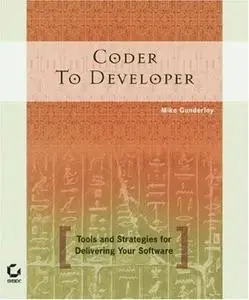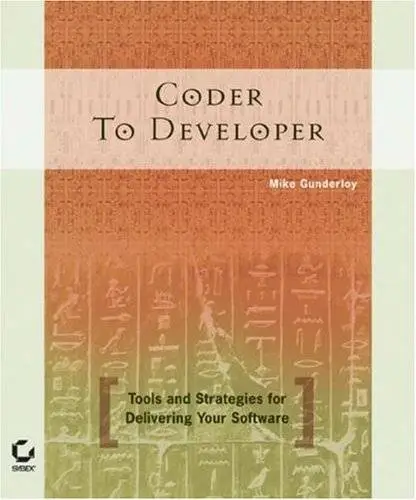Mike Gunderloy, "Coder to Developer: Tools and Strategies for Delivering Your Software"
Sybex | ISBN 078214327X | 2004 | CHM | 352 pages | 10 Mb
Sybex | ISBN 078214327X | 2004 | CHM | 352 pages | 10 Mb
This book teaches how to be better engineer in the areas outside of strict coding. Yes, it teaches a little about specific coding practices, but the intent of the book is to cover the breadth of skills required of a true developer. Skills like project management, architecture, engineering process, source code control, and relating to the customer. These are the types of career skills than will move you from a coder cog to an invaluable developer.
Mike finds the right depth in the book, not too deep into the technical details, nor so abstract as to be an architectural tome for the ages. When it comes to coding the book is primarily focused on C# on the .NET platform, but you should let that dissuade you. He covers a wide variety of techniques and technologies and the book is valuable for anyone involved in the engineering side of the software industry.
Chapter one covers planning out your project. It covers gathering requirements and how to decide on a development methodology for the project. It gives a decent overview of all of the popular development methodologies and pointers as to where to learn more. It also covers some software that you probably didn't know was out there but that can help you as you nailing down the feature set.
Chapter two covers architecture and gives a nice overview of both the UML and Patterns side of the business, and the more fast and loose XP development process.
Chapter three covers source code control and it's one of the best chapters in the book. When I got through chapter three I knew already that the book was worth the purchase price. This chapter covers in a very concise manner the best practices of source code control and the products that are available on the market.
Chapter four is a brief introduction to sane coding practices; using tools like assertions and exceptions, and how to comment code effectively.
Chapter five gives a high level, but insightful, summary of the unit testing, system testing, and the technique and benefits of test driven development. This is one of the best chapters.
Chapter six covers the IDE and how to make the best use of it. This is a fairly Microsoft specific chapter, but you can learn some tricks that are applicable to other development environments.
Chapter seven covers a topic which is often ignored, the skill of digging into code at the system level and finding your way around. This one is definitely .NET specific, and it was a little too low level for me. Your mileage may vary.
Chapter eight covers code generation, a topic near and dear to me. It's a very practical chapter introduction and should save .NET developers a lot of time.
Chapter nine is about bug tracking and fixing. As with the rest of the chapter this is a concise introduction to the topic that gives you a feeling for the benefits of bug tracking, which should be obvious, and advice about tools and process. Once again I have never seen a book that provides a good argument with the brevity of Mike's writing style. Code Complete, for example, covers this stuff, but it's thick and impenetrable. This book gets right to the core of the topic and presents it in a very accessible way.
Chapter ten covers logging, which can be overdone. Again pragmatic and practical advice. But this chapter is fairly .NET specific.
Chapter eleven is about the dynamics of small teams. He introduces Instant Messaging, Wikis, and group ware. A nice introduction, but a bit brief.
Chapter twelve is about both end-user and code documentation and the tools to develop it quickly.
Chapter thirteen covers the build process. The tools are fairly .NET specific (nant), but the process and the methodology are appropriate to any production software development shop. Another nice chapter with content you will be hard pressed to find in such a concise form anywhere else.
Chapter fourteen is about licensing. This is important for open source developers. It has a nice comparison of the popular open source licenses and makes sense of all of the legal gobbledygook.
Chapter fifteen is about installers and application delivery. It's primarily for .NET desktop application developers.
There is an old story about a developer that is walking out of a tech show empty-handed, he says to the security guard that he 'Stole a fortune'. The security guard, puzzled, asks, 'But you have nothing.' The developer responds that he now has new ideas! This is that kind of book. It's full of ideas for the software process, ideas about how to code, and ideas about tools you can use.
Better together with "Developer to Designer: GUI Design for the Busy Developer" from the same author.



